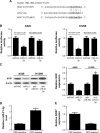LncRNA MEG3 enhances cisplatin sensitivity in non-small cell lung cancer by regulating miR-21-5p/SOX7 axis
- PMID: 29123412
- PMCID: PMC5661845
- DOI: 10.2147/OTT.S146423
LncRNA MEG3 enhances cisplatin sensitivity in non-small cell lung cancer by regulating miR-21-5p/SOX7 axis
Abstract
Background: Long noncoding RNAs (lncRNAs) have been revealed to play essential role in drug resistance of multiple cancers. LncRNA MEG3 was previously reported to be associated with cisplatin (DDP) resistance in non-small cell lung cancer (NSCLC) cells. However, the molecular mechanism of MEG3 affecting DDP resistance in NSCLC remains to be further illustrated. In this study, we attempted to discuss whether MEG3 also could function as a competing endogenous RNA to regulate DDP resistance in NSCLC.
Materials and methods: The expression of MEG3, miR-21-5p, and sex-determining region Y-box 7 (SOX7) in NSCLC tissues or cells was examined by quantitative real-time polymerase chain reaction (qRT-PCR). 3-(4,5-Dimethylthazol-2-yl)-2,5-diphenyltetrazolium bromide (MTT), flow cytometry, and caspase-3 activity analysis were applied to assess the DDP sensitivity of NSCLC cells. The interaction between MEG3, miR-21-5p, and SOX7 was explored by luciferase reporter assay, RNA immunoprecipitation (RIP) assay, qRT-PCR, and Western blot. Mouse NSCLC transplanted tumor was established to verify the functional role of MEG3 in DDP resistance in vivo.
Results: MEG3 was downregulated in DDP-resistant NSCLC cells. Overexpression of MEG3 enhanced DDP sensitivity of NSCLC cells in vitro. MEG3 directly interacted with miR-21-5p and suppressed its expression. miR-21-5p significantly abolished the effects of MEG3 on DDP resistance via modulating cell proliferation and apoptosis. SOX7 was identified as a direct target of miR-21-5p and MEG3 positively regulated SOX7 expression by suppressing miR-21-5p. Moreover, MEG3 knockdown-induced pro-proliferative and anti-apoptotic effects were reversed in DDP-resistant NSCLC cells by upregulating SOX7. Furthermore, upregulation of MEG3 induced sensitivity of NSCLC cells to DDP in vivo.
Conclusion: MEG3 overexpression induced DDP sensitivity of NSCLC cells by regulating miR-21-5p/SOX7 axis, shedding light on the molecular mechanism of MEG3 involved in the development of DDP resistance of NSCLC cells.
Keywords: DDP resistance; MEG3; NSCLC; miR-21-5p/SOX7.
Conflict of interest statement
Disclosure The authors report no conflicts of interest in this work.
Figures







Similar articles
-
LncRNA SNHG1 contributes to the cisplatin resistance and progression of NSCLC via miR-330-5p/DCLK1 axis.Exp Mol Pathol. 2021 Jun;120:104633. doi: 10.1016/j.yexmp.2021.104633. Epub 2021 Mar 19. Exp Mol Pathol. 2021. PMID: 33753110
-
MiR-200c-3p and miR-485-5p overexpression elevates cisplatin sensitivity and suppresses the malignant phenotypes of non-small cell lung cancer cells through targeting RRM2.Thorac Cancer. 2022 Jul;13(13):1974-1985. doi: 10.1111/1759-7714.14475. Epub 2022 May 22. Thorac Cancer. 2022. PMID: 35599447 Free PMC article.
-
Knockdown of Long Non-Coding RNA HOTAIR Suppresses Cisplatin Resistance, Cell Proliferation, Migration and Invasion of DDP-Resistant NSCLC Cells by Targeting miR-149-5p/Doublecortin-Like Kinase 1 Axis.Cancer Manag Res. 2020 Aug 24;12:7725-7737. doi: 10.2147/CMAR.S246299. eCollection 2020. Cancer Manag Res. 2020. PMID: 32943921 Free PMC article.
-
Circ_PIP5K1A regulates cisplatin resistance and malignant progression in non-small cell lung cancer cells and xenograft murine model via depending on miR-493-5p/ROCK1 axis.Respir Res. 2021 Sep 18;22(1):248. doi: 10.1186/s12931-021-01840-7. Respir Res. 2021. PMID: 34537072 Free PMC article.
-
The Biological Roles and Molecular Mechanisms of Long Non-Coding RNA MEG3 in the Hallmarks of Cancer.Cancers (Basel). 2022 Dec 7;14(24):6032. doi: 10.3390/cancers14246032. Cancers (Basel). 2022. PMID: 36551518 Free PMC article. Review.
Cited by
-
LncRNAs in Non-Small-Cell Lung Cancer.Noncoding RNA. 2020 Jun 30;6(3):25. doi: 10.3390/ncrna6030025. Noncoding RNA. 2020. PMID: 32629922 Free PMC article. Review.
-
LINC00941 Promotes Progression of Non-Small Cell Lung Cancer by Sponging miR-877-3p to Regulate VEGFA Expression.Front Oncol. 2021 Mar 31;11:650037. doi: 10.3389/fonc.2021.650037. eCollection 2021. Front Oncol. 2021. PMID: 33869051 Free PMC article.
-
Exosomal miR-21-5p contributes to ovarian cancer progression by regulating CDK6.Hum Cell. 2021 Jul;34(4):1185-1196. doi: 10.1007/s13577-021-00522-2. Epub 2021 Apr 3. Hum Cell. 2021. PMID: 33813728
-
Hypermethylation and reduced expression of Gtl2, Rian and Mirg at the Dlk1-Dio3 imprinted locus as a marker for poor developmental potential of mouse embryonic stem cells.Stem Cell Res. 2020 Oct;48:101931. doi: 10.1016/j.scr.2020.101931. Epub 2020 Jul 29. Stem Cell Res. 2020. PMID: 32822966 Free PMC article.
-
lncRNA FOXD2-AS1 confers cisplatin resistance of non-small-cell lung cancer via regulation of miR185-5p-SIX1 axis.Onco Targets Ther. 2019 Jul 30;12:6105-6117. doi: 10.2147/OTT.S197454. eCollection 2019. Onco Targets Ther. 2019. PMID: 31534348 Free PMC article.
References
LinkOut - more resources
Full Text Sources
Other Literature Sources
Research Materials
Miscellaneous

